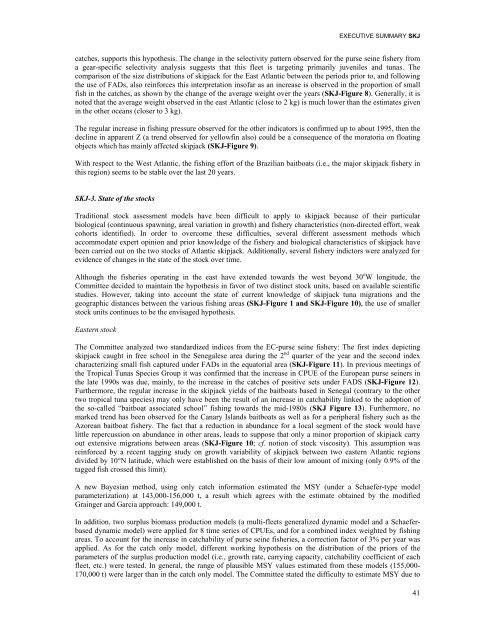REPORT OF THE STANDING COMMITTEE ON RESEARCH ... - Iccat
REPORT OF THE STANDING COMMITTEE ON RESEARCH ... - Iccat
REPORT OF THE STANDING COMMITTEE ON RESEARCH ... - Iccat
You also want an ePaper? Increase the reach of your titles
YUMPU automatically turns print PDFs into web optimized ePapers that Google loves.
EXECUTIVE SUMMARY SKJcatches, supports this hypothesis. The change in the selectivity pattern observed for the purse seine fishery froma gear-specific selectivity analysis suggests that this fleet is targeting primarily juveniles and tunas. Thecomparison of the size distributions of skipjack for the East Atlantic between the periods prior to, and followingthe use of FADs, also reinforces this interpretation insofar as an increase is observed in the proportion of smallfish in the catches, as shown by the change of the average weight over the years (SKJ-Figure 8). Generally, it isnoted that the average weight observed in the east Atlantic (close to 2 kg) is much lower than the estimates givenin the other oceans (closer to 3 kg).The regular increase in fishing pressure observed for the other indicators is confirmed up to about 1995, then thedecline in apparent Z (a trend observed for yellowfin also) could be a consequence of the moratoria on floatingobjects which has mainly affected skipjack (SKJ-Figure 9).With respect to the West Atlantic, the fishing effort of the Brazilian baitboats (i.e., the major skipjack fishery inthis region) seems to be stable over the last 20 years.SKJ-3. State of the stocksTraditional stock assessment models have been difficult to apply to skipjack because of their particularbiological (continuous spawning, areal variation in growth) and fishery characteristics (non-directed effort, weakcohorts identified). In order to overcome these difficulties, several different assessment methods whichaccommodate expert opinion and prior knowledge of the fishery and biological characteristics of skipjack havebeen carried out on the two stocks of Atlantic skipjack. Additionally, several fishery indictors were analyzed forevidence of changes in the state of the stock over time.Although the fisheries operating in the east have extended towards the west beyond 30 o W longitude, theCommittee decided to maintain the hypothesis in favor of two distinct stock units, based on available scientificstudies. However, taking into account the state of current knowledge of skipjack tuna migrations and thegeographic distances between the various fishing areas (SKJ-Figure 1 and SKJ-Figure 10), the use of smallerstock units continues to be the envisaged hypothesis.Eastern stockThe Committee analyzed two standardized indices from the EC-purse seine fishery: The first index depictingskipjack caught in free school in the Senegalese area during the 2 nd quarter of the year and the second indexcharacterizing small fish captured under FADs in the equatorial area (SKJ-Figure 11). In previous meetings ofthe Tropical Tunas Species Group it was confirmed that the increase in CPUE of the European purse seiners inthe late 1990s was due, mainly, to the increase in the catches of positive sets under FADS (SKJ-Figure 12).Furthermore, the regular increase in the skipjack yields of the baitboats based in Senegal (contrary to the othertwo tropical tuna species) may only have been the result of an increase in catchability linked to the adoption ofthe so-called “baitboat associated school” fishing towards the mid-1980s (SKJ Figure 13). Furthermore, nomarked trend has been observed for the Canary Islands baitboats as well as for a peripheral fishery such as theAzorean baitboat fishery. The fact that a reduction in abundance for a local segment of the stock would havelittle repercussion on abundance in other areas, leads to suppose that only a minor proportion of skipjack carryout extensive migrations between areas (SKJ-Figure 10; cf. notion of stock viscosity). This assumption wasreinforced by a recent tagging study on growth variability of skipjack between two eastern Atlantic regionsdivided by 10°N latitude, which were established on the basis of their low amount of mixing (only 0.9% of thetagged fish crossed this limit).A new Bayesian method, using only catch information estimated the MSY (under a Schaefer-type modelparameterization) at 143,000-156,000 t, a result which agrees with the estimate obtained by the modifiedGrainger and Garcia approach: 149,000 t.In addition, two surplus biomass production models (a multi-fleets generalized dynamic model and a Schaeferbaseddynamic model) were applied for 8 time series of CPUEs, and for a combined index weighted by fishingareas. To account for the increase in catchability of purse seine fisheries, a correction factor of 3% per year wasapplied. As for the catch only model, different working hypothesis on the distribution of the priors of theparameters of the surplus production model (i.e., growth rate, carrying capacity, catchability coefficient of eachfleet, etc.) were tested. In general, the range of plausible MSY values estimated from these models (155,000-170,000 t) were larger than in the catch only model. The Committee stated the difficulty to estimate MSY due to41
















